A new Lowestoft smoker, an old smokehouse and red herrings among the kippers, bloaters and many other hot and cold smoked products
SMOKEHOUSE TALES: GERRY SKEWS
Waveney Valley Smokehouse, Lowestoft
In the late 1990s I made a radio series about preserved fish, the last of which was about red herring. This became, in fact, the starting point for the herripedia. Unlike the other subjects, I never felt I had got to the bottom of the herring and its many stories. I still haven’t. As a red herring smoker, I met Sam Cole in Lowestoft at a stall he had by the beach – I didn’t visit his smokehouse. I remember it as a richly informative and amusing interview. I then drove on up to Great Yarmouth and interviewed Mike Kelly of HS Fish and was treated to a tour of their smoking operation.
When I was trying to get hold of red herring again, in late 2020, I discovered HS Fish had closed. The only producers I was able to find were both in Lowestoft: Waveney Valley Smokehouse, which provides an online/postal service, and The Old Smokehouse, which doesn’t. Very different operations, they both produce excellent smoked fish.
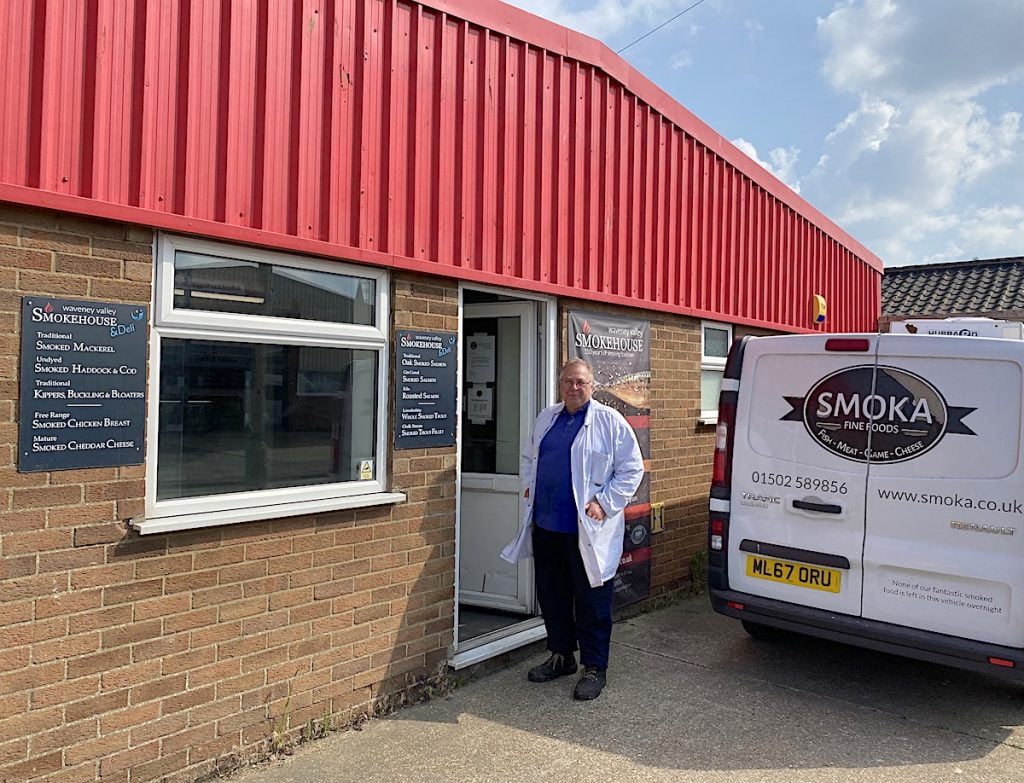
The Smokehouse
So, Sam Cole used to own this place. In fact it was his grandfather, possibly his great grandfather that bought this old building here. We haven’t changed the actual smokehouse, but we’ve changed all the buildings and everything around it.
It was JT Cole years ago, but then it has passed through the ownership of many people. It used to be the heart of the herring industry in Lowestoft, which was, really, pretty much in this area. It’s called The Grit or The Beach Village and certainly goes back to the C14th, so they’ve been landing herring here for a long time.
I don’t know exactly how old this smokehouse is but it’s on all the old maps.
Becoming a Smoker
I’d had 30 years in medical and clinical research. It was a natural jump, to go into smoking fish…
Well, we’d retired. We bought a house and a boat in Lowestoft and got fairly bored fairly quickly. We saw this old smokehouse all shut up and shuttered and there was a sign on it, saying, Any information please call Sam Cole.
So, we rang and said, We’re quite interested… There was a little chuckle on the end of the phone. Obviously I sounded like a fish on the hook at that point. So I met with Sam and we had a look round this place, next door, and said Why not?
Herring and kippers, they used to be a childhood common occurence. We would have kippers and bloaters and the like. I kind of thought, well, they haven’t passed from use…
The UK market is about £15 million. It’s not a tiny market. It’s not a big market, when you consider the salmon market’s £1.3 billion. I thought, Well, I wonder who does kippers well. I looked around and there was Craster. There’s a lot of kippers coming out of the Isle of Man. Manx kippers tend to be small. There’s a few smokehouses around, who are doing them and I thought, Perhaps there’s a local market… We took the plunge and we ended up pretty busy.
Now, we do just under a ton of herring a week. We get a reasonable demand for all of them: the buckling; we do a lot of kippers; we do quite a lot of bloaters. We don’t do many red herrings, but we do keep a stock. We always have some on the go in the rafters of one of the smokehouses.
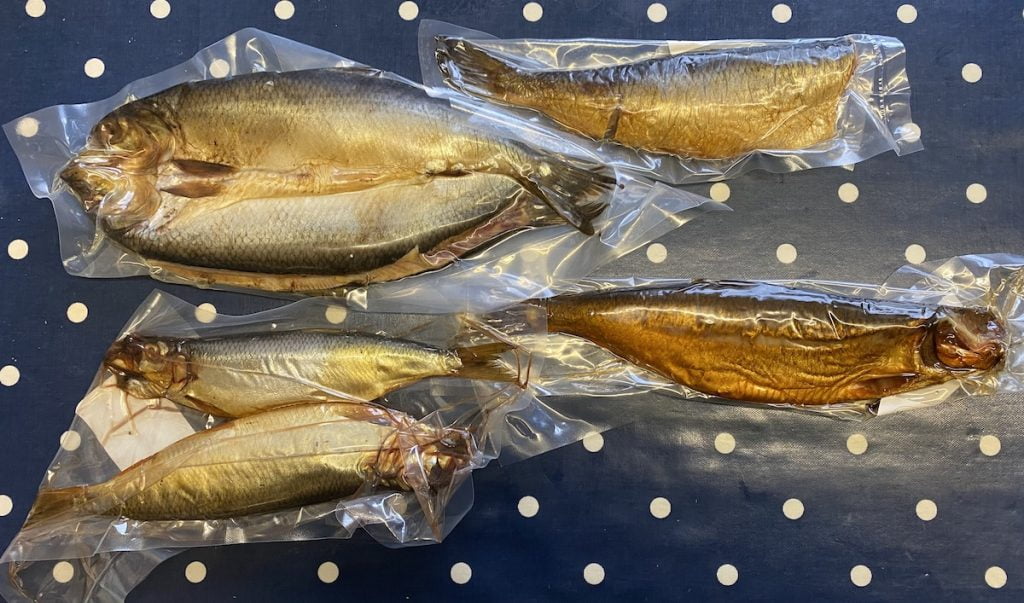
Learning the Trade
I talked to several people, who had talked to several people, who had talked to several people… If there’s a hundred people you talk to, you’re going to get a hundred and ten opinions on how to do it. But the basic principles aren’t complicated. The challenge is consistency.
The things that we wanted to do here were quality, consistency and safety: a consistently high quality product consistently, that would conform all the regulations and rules. If you look at the process, it’s basically the fish, the curing, the smoking, the post-smoking and the care of the product through the chill-chain. Of course, the variables in all of that are significant.
Basically, what I did was to look at the actual mechanical process of producing a kipper or a red and I optimised the process myself. So, if we take a 350gm herring and we gut it and we butterfly it and we dry salt it and we smoke it for 24 hours over oak fires with a burn rate of whatever it is, we end up with a product. What does it taste like?
Well, we cook it, we taste it. It’s OK. It’s nice. It’s bloody salty. So what are the other alternatives? Well, let’s look at a wet brine. So, OK, what do we use in the way of salt to create the wet brine? There’s fine grained salt, coarse salt, sea salt… Everybody swears by whatever they happen to use.
We settled on a PDV mineral kosher salt: fine grained; dissolves quickly in the tanks. We were the only people round here doing it. Everybody else uses rock salt or cheap salt, basically, to get the concentration up.
We went for a more expensive salt, but the quality and the consistency when we measure it is good: it doesn’t give up its salt easily, the salt concentration doesn’t change. So we make brining tanks, not huge brining tanks, fairly small brining tanks, 60% saline concentration, and that does us for pretty much most of the wet brining products that we produce. We just vary the time. We’ve got to end up with 3.5% salt in the aqueous phase in the final product. That’s the safety bit.
So, when we measure the salt concentration, we take a product, mush it up, mix it up with distilled water, measure the salt concentration. It’s got to be over 3.5. Generally, it is about 3.5. If you go more than 3.5, there is a strong salt taste to it and then you have to recommend to the customer that they soak it before they use it. That’s not a practical solution, unless the customer’s really dedicated.
What most people want to do is to take it out of the bag – or not take it out of the bag – cook it and eat it. They’re looking for a good smoke and a good salt.
So we did it recursively, we did it empirically: we measured, we tested, we tried. In essence it’s a method that we have developed and, like all of our products we use a methods development sheet, which basically describes exactly what we want to do, how we want to do it. When we bring people in, we train them on that: on that particular method.
Sometimes, we still might not get it right. It’s hot today: we run the kilns tonight, the kippers are going to be almost cooked, because they don’t need to be much more than 25° before the flesh starts to cook. But we develop a method that we think is right and we try to reproduce that.
Smoking Red Herring
When we started we weren’t focused on the reds, it was just the kippers, bloaters, buckling and kipper fillets. It’s purely that people have asked for it. A few people would say, Oh when I used to go down the pub years ago, we’d have red herrings on the bar… The landlord knew what he was doing because they’re very salty: a few of those, a few more pints and there you go.
Then we started seeing a few people say, Oh, we’ll take a red herring… We’ll take a couple of red herrings, and that’s where it is. It’s not a big part of our business. It’s almost a service we offer. And some of the longshore herrings, which are smaller, we’ll do as reds – you get them on a speat and they’re absolutely fine. I wouldn’t want to fillet them, I wouldn’t want to butterfly them, but to put them on a speat and put them in the top of the kiln, that’s absolutely fine: almost like a snack, a finger snack.
We had a meeting in London on Saturday, a guy from Egypt brought some smoked herring along. He said, I think there’s a market in this country for this product. Can you make something like this? And it’s somewhere between a bloater and a red, really.
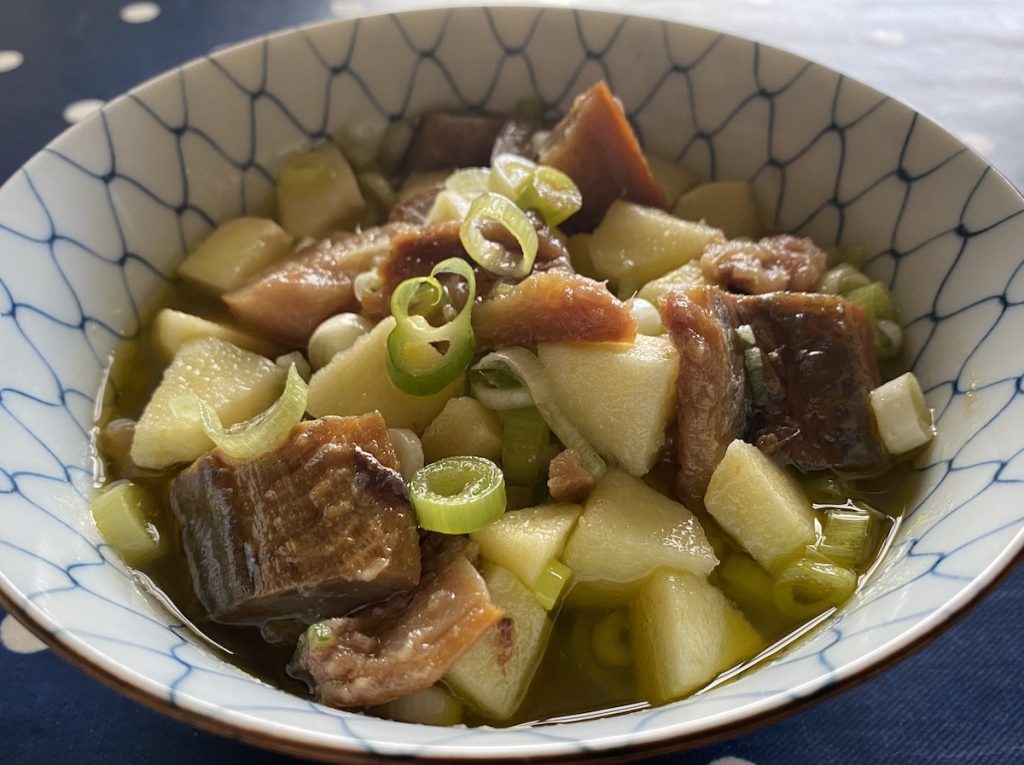
with Waveney Valley red herring
We do the reds for about twelve weeks. The thing is, once they’ve had a couple of smokes, they’ve begun to dehydrate so much that there’s no serious microbial activity going on anyway. When the water content of the product gets below about 80%, it’s very difficult for bacteria to grow. Mould can still grow, but we don’t have any mould in the smokehouse. So, in a protected environment, they just keep smoking away. In that kiln we do probably four smokes a week and we leave them in there about twelve weeks, so they come out nice and red.
HS Fish in Yarmouth, which closed two or three years ago, they used to do a lot of exporting and most of their herring was very well salted. We tend not to salt the herring that much, because we’re really going after a flavour not a preservation technique. We tend to rely on dehydration, vacuum packing and chill-chain shipping to maintain the life of the product.
We only put three weeks life on a vacuumed product. Truth be told, they will keep longer. I’ve eaten them a lot longer than that. But, as said, most of our work now is about trying to enhance the flavour of the product and trying to give a natural smoke to the product, rather than ultra-preserving. So it has changed to that extent. Reds are probably the exception to the rule, because I think they’re pretty much indestructible.
Approaches to Smoking
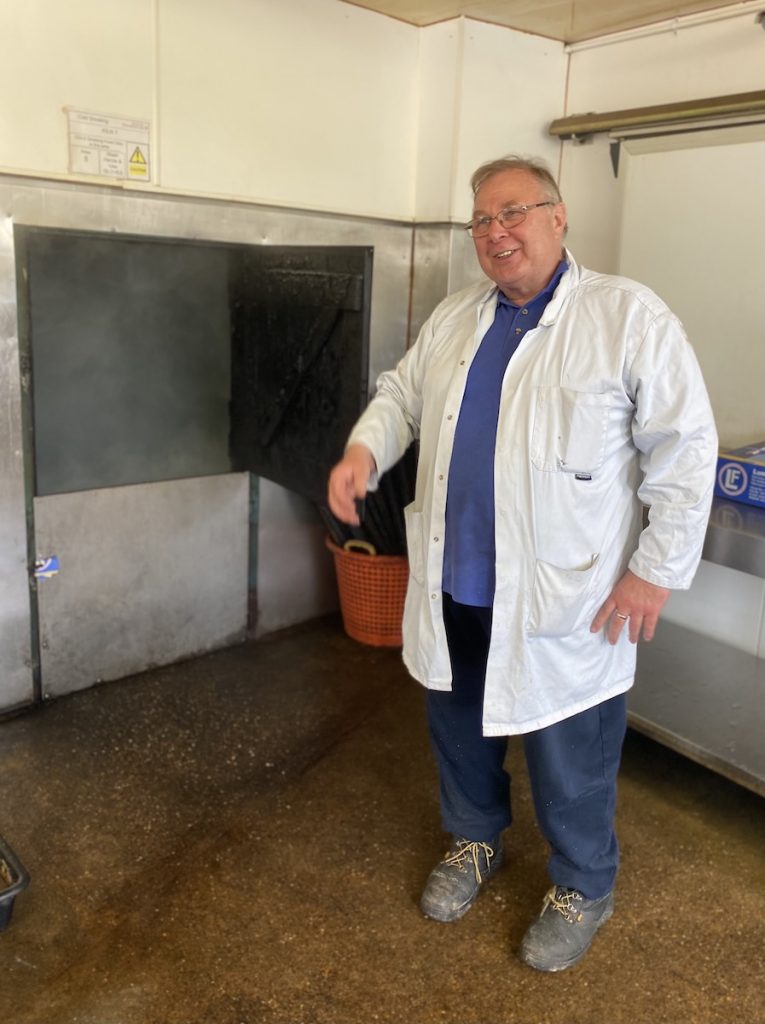
A lot of the products now have got dyes in. They use a very low molecular weight yellow dye to soak into the flesh. I never think a dye of that nature is going to be very healthy. A lot of the food dyes that used to be used, that had that effect, have been banned. There are still some dyes you can use for haddock and herring, but we made a decision that we wouldn’t use a dye here for any of our products.
The other thing that affects the absorption of smoke is the oil content, so, when the fish has been caught has an impact on what the actual final product is like. You can get a much more oil-rich product at certain times of the year, when they’re getting ready to spawn, for example.
We buy the local inshore or longshore herring that we get here, but we can’t rely upon it. Our herring normally comes in through Grimsby, but it’s Norwegian-caught and we buy it in twenty kilo block-frozen boxes. To be fair, we get through so much of it we need a standard.
They’re still not an expensive fish. Nothing’s cheap these days, but I guess we’re paying about a pound a kilo for it. That’s not expensive by fish standards. The thing I like about it is it’s sustainable. The Norwegians don’t take more than they need. They take a lot of fish but herring is a very versatile, durable product.
Looking to the Future
My son’s just joined the business this week. He’s been in London thirteen years doing something else, but he likes the food industry. So we’ve just started a fresh fish business and he’s going to set that up and run it.
We’ve just been awarded a pitch on Borough Market in London, so we’re looking to go down there. We applied two years ago and they wrote to us a year and a bit ago. They said, There’s about two hundred people interested in the pitch. If you’re interested, fill in all these forms, send all this information off about the company… Which we did.
We didn’t hear any more and then they wrote and said, Your products look interesting, we’ve done some due diligence, would you be prepared to send some products down to a taste panel – which is food critics and local chefs. That got put on hold because of the COVID outbreak. But then they wrote again and said, We’re still interested, are you still prepared? So we said, Yes. And they said, OK.
The panel has fifty foods or fifty things to try and they rank them all. It’s all done blind – we weren’t allowed to put labels on. We sent hot smoked salmon, cold smoked salmon, smoked mackerel, trout… We didn’t send any herring. We’d put it on the list to sell, but they said, You’ve got to limit things for the tasting… If fifty people want a pitch there, those poor people are going to have to try a hundred and fifty foods!
We didn’t hear anything for a few weeks, then we got an email on Friday, Congratulations, we’d like to offer you a pitch.
So what we’re doing, now, with the website, is allowing people to order online and pick up from the market. That’s on the fresh fish side, but we’re obviously going to be doing smoked fish as well. And when you order, you can choose where to pick it up: say Maisebrooke Farm Shop, Beeston Garden Centre or Pastures Garden Centre on Fridays, North Norfolk… Essentially, we’d add Borough Market to those outlets. Then all we need to do is advertise things! But ultimately, that way, we’ll build it up.
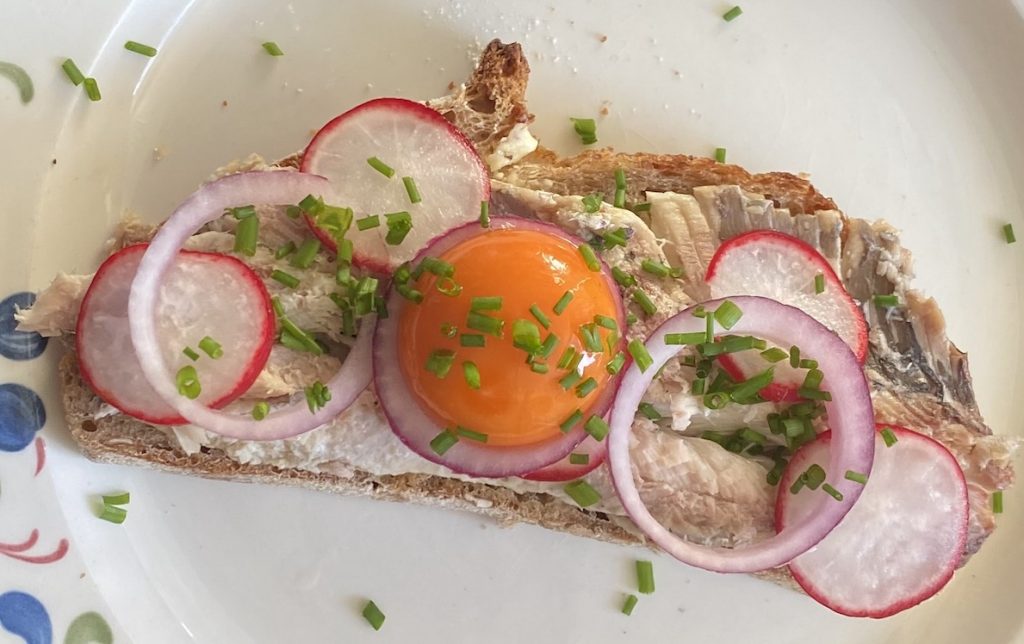
Waveney Valley Products
Smoked Herring: whole kippers, kipper fillets (cold smoked), kipper fillets (hot smoked), buckling (hot smoked), bloaters, red herring.
Other smoked fish: salmon (hot smoked, cold smoked, gravalax); mackerel (hot smoked); trout (cold smoked); haddock (cold smoked); cod (cold smoked).
Fresh fish, shellfish other deli foods.
Contact
Waveney Valley Smokehouse, Newcombe Road, Lowestoft, NR32 1XA
Tel: 01502 589856
Email: gerry@smoka.co.uk
See also
- BLACK HERRING
- BLOATER
- BRITISH FISHERY
- BRITTEN
- BUCKLING
- DRIED HERRING
- DRIFT OR GILL NETTING
- FASTING
- FLEAS
- GOLDEN HERRING
- GREEN HERRING
- HARENG SAUR
- HARENG SAUR MONOLOGUES
- KIPPER
- MONKEY BUSINESS
- MUIR, JIM (HERRING INTERVIEW, ACHILTIBUIE)
- NASHES LENTEN STUFFE
- PICKELHERING
- RED HERRING
- RED HERRING JOKE, THE
- ROLLMOPS & BISMARCKS
- SALT
- SCHMALTZ HERRING
- SHOALS
- SHOALS OF HERRING, THE
- SINGING THE FISHING
- SUFFERING SALTWORKERS OF SHIELDS
- SURSTRÖMMING
- WHITE HERRING
- WITCHCRAFT
